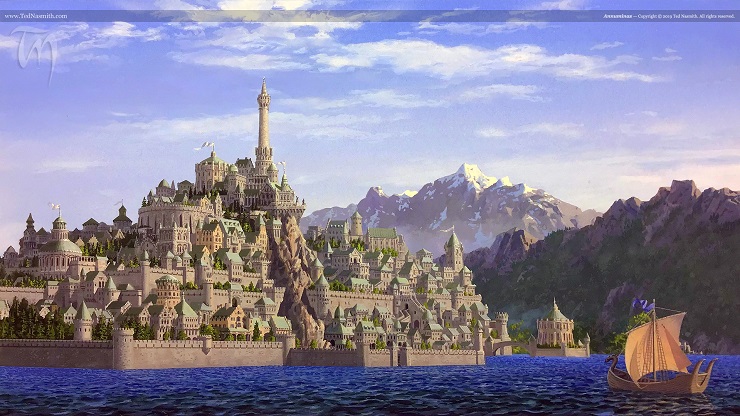We’ve known for some time now that Amazon’s Rings of Power series is going to be set during the Second Age. But in this article, I intend to walk through the basic events of the Second Age according to what Tolkien wrote. Did he detail the Second Age much? Nope. Is there still plenty to read through? Totally. He still sketched out the basics.
But let’s be clear. This article isn’t about what showrunners JD Payne and Patrick McKay’s are doing in their show. Which could well be awesome, even though it’s likely to be quite different than what Tolkien devised for that same age of Middle-earth that brought us the sea-kings of Westernesse, the rise of Mordor, and a batch of perilous magical rings. We’ll just have to wait and see about the show, and talk about it another day. Again, this article will focus on Tolkien’s own ideas and plots for the Second Age of Middle-earth, spare as they may be compared to the First Age (the bulk of The Silmarillion) and the latter Third Age (The Lord of the Rings).
First, a word about literary canon. The term “canon” gets thrown around a lot these days without much thought. It’s often misunderstood or misused, and it becomes even more nebulous when applied to Tolkien. Strip away the religious associations from the word (which is hard to do, as it’s so rooted in the concept of Church doctrine) and you’re left with a definition like “the authentic works of a writer.” Which means everything that J.R.R. Tolkien wrote and had published during his lifetime is canon. And the rest . . . is also canon.
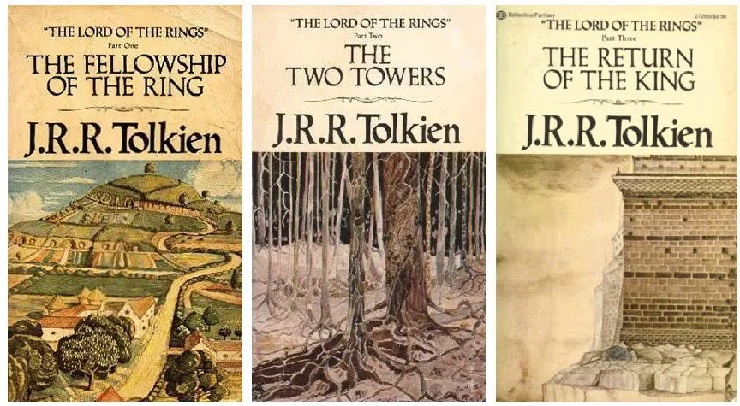
So let’s be clear on something else. Both The Hobbit and The Lord of the Rings were published when Tolkien was still alive. They went to print on his watch, and even those two works have a few minor contradictions between them. Everything else—including The Silmarillion (1977), Unfinished Tales (1980), the entire 12-volume History of Middle-earth series (1983–1996), the Great Tales compilations (The Children of Hurin, Beren and Lúthien, and The Fall of Gondolin) and The Nature of Middle-earth (2021)—was published after his death in 1973. Yet Christopher Tolkien did so with the utmost care and respect for his father’s work and legacy. He took pains, in at times labyrinthine fashion, to record the proper chronology in his father’s life with these works, not to mention curating the copious, if confusing notes that identify one draft vs. another—and always making it clear what his father wrote vs. what he himself summarized. These vast amounts of material often don’t add up or agree with one another’s particular details.
Which . . . of course they don’t. These were Tolkien’s unfinished notes and essays; only sometimes do they read like he was preparing them for publication. The full breadth of the man’s writings about Middle-earth and its environs, published and unpublished, over the span of decades, are riddled with wonderful if sometimes contradictory ideas.

For example, Tolkien invented a mythology about how the Sun and Moon showed up in the second act of his fantasy world (as it appears in the published Silmarillion), only to decide later in life that he’d rather align his fictional cosmology with the real world’s own. But he died before he could properly execute that endeavor. My point is, in Tolkien, nothing is canon and everything is. The Sun is the last fruit of one of the Two Trees—no, wait, the Sun is maybe a mass of incandescent gas, after all, and it’s been there all along? Or not. Dwarf women are rarely seen and are nearly indistinguishable from Dwarf men, and possibly had beards—but wait, insists a later footnote, only male dwarves for sure had them, thus implying that females don’t, necessarily.
Everything’s perfectly all right now. We’re fine. We’re all fine here now, thank you. How are you?
So all right, let’s talk about the Second Age as Tolkien worked it up in various parts. Now, if you’d like to skip my paraphrasing and go right to the Númenórean horse’s mouth, scroll to the bottom, where I cite the books where Tolkien wrote about peoples, places, and things of the Second Age. Otherwise, read on.
The First Age and a Glossary
The First Age ended when the War of Wrath did, and the Host of the Valar withdrew from Middle-earth. Morgoth, the OG Dark Lord, had been defeated at long last and the Valar actually physically removed him from Arda. That is, from the world itself. So the Second Age, which begins with the world recovering from that great war, will last for 3,441 years as written, and it will end with the defeat of Sauron, the new Dark Lord. Well, with Sauron’s first defeat, that is. Here’s a short glossary for what follows.
- Beleriand – A vast region in the northwest of corner of Middle-earth, roughly the size of Eriador, in which most of the First Age played out. During the War of Wrath, Beleriand is so “rent asunder” that it eventually sank into the sea (probably over a long period of time).
- Edain – Meaning “Elf-friends,” it is the collective name for the groups of Men who allied with Elves and fought against Morgoth in the First Age. They are gifted with a sweet island, longer life, and a whole lot of talent. They become the Númenóreans.
- Eru Ilúvatar – The monotheistic God of all things. He is remote, yet not entirely hands-off.
- Maiar – An order of spiritual beings “lesser” than the Valar. Sauron, Gandalf, Saruman, and the Balrogs are all Maiar.
- Melkor / Morgoth – An ex-Vala, the originator of all evil, the original Dark Lord; Sauron’s old boss.
- Noldor – A kindred of Elves who traveled to Valinor long before; the majority of them eventually rebelled (it’s complicated) and went into exile, returning to Middle-earth to establish realms of their own and to wage war against Morgoth. But with Morgoth defeated, they were now pardoned and permitted to return to Valinor, if they wanted to. Galadriel, Gil-galad, and Celebrimbor are among the Noldor who remained behind. Elrond has some Noldorin blood in him, but he’s got an impressively mixed ancestry.
- Númenor – The island the Edain were given as a reward for their valor in the War of Wrath. Placed far out on the Great Sea by the Valar, it is far from the coasts of Middle-earth.
- Númenóreans – The “sea-kings” as they’re sometimes called in The Lord of the Rings. The Men of Westernesse. They are physically quite tall, very long-lived (but they are still mortal, that’s important), and are highly skilled at nearly everything. They represent the peak civilization of Men.
- Valar – The Powers, the little-g gods of Arda, such as Manwë, Varda (Elbereth), Ulmo, and Aulë.
- Valinor – The land of the Valar, located on the continent of Aman. Also called the Undying Lands, so named for the presence of the Valar and the Maiar, not because the land itself prevents death.
- War of Wrath – The Great Battle at the end of the First Age, when the Host of the Valar (which consisted of at least a lot of Maiar and a bunch of Elves from Valinor) overthrew Morgoth. The Edain joined in, too. The Noldor sat this one out, having fought in nearly every battle before it and suffering vastly depleted numbers.
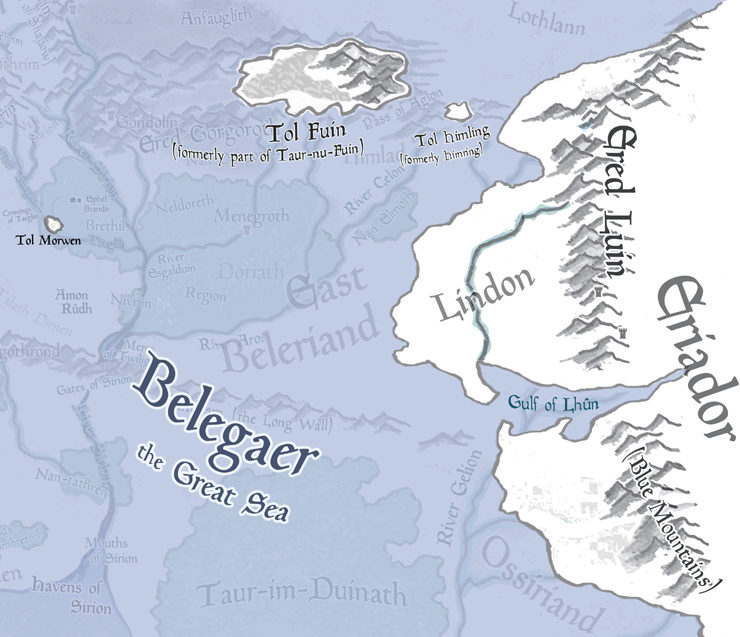
Charting the Second Age
A truly comprehensive timeline can be cobbled together if you add up all dates given from various sources (the Tolkien Gateway site does this wonderfully). But for simplicity’s sake, I’d like to frame this summary using only the dates and entries given in Appendix B of The Lord of the Rings, a.k.a. The Tale of Years. I’ll follow each with a brief abstract of what each one signifies.
1 – Foundations of the Grey Havens, and of Lindon.
Lindon is where the Noldor who chose to remain in Middle-earth decide to settle (choosing to not yet sail west, returning to Valinor). In fact, Lindon and the Blue Mountains next to it are really the only parts of Beleriand that didn’t sink into the waters of the Great Sea after the War of Wrath. The Grey Havens is the harbor from which Elven ships set sail and to which friendly ships are received—and of course it’s where Frodo, Bilbo, Gandalf, etc. leave Middle-earth at the end of The Lord of the Rings.
32 – The Edain reach Númenor.
The Edain are the Elf-friends. That is, the great clans of Men (of various tribes and houses) who fought against Morgoth in the First Age. As a reward for this courageous service, they are given the island of Númenor far out on the Great Sea. Here they will be free to live their own lives, raise a civilization of their own unconnected to the larger world, and enjoy the gifts given to them by the Lords of the West. That is, “wisdom and power and life more enduring than others of mortal race.” They were free to build ships and roam the seas, too. But there is one important rule they must abide by: no sailing west so far that they cannot see the coastline of Númenor itself.
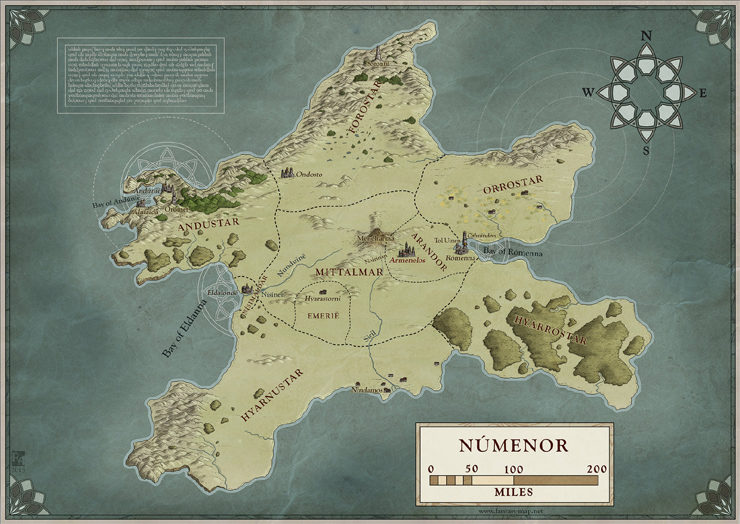
Even so, they’re good friends with the Elves, who sail over from Valinor sometimes and bring gifts. Most notable is the white tree, Nimloth, brought as a seedling from the Undying Lands. It would become a symbol of the nobility of Númenor and its kings. And the tree’s own descendants would carry on all the way to Gondor someday.
40 – Many Dwarves leaving their old cities in Ered Luin go to Moria and swell its numbers.
Khazad-dûm (later called Moria by the Elves) is the largest of all Dwarven kingdoms. Two cities in Ered Luin (the Blue Mountains), Nogrod and Belegost, were ruined in the War of Wrath. But not all Dwarves leave. There are some communities and mines there.
442 – Death of Elros Tar-Minyatur.
Elros, the brother of Elrond who chose mortality, was given the name Tar-Minyatur, and he became the first king of Númenor. Knowing Númenor was founded in the year 32, and now we’re at 442, shows us just how long-lived the royal Númenóreans are. For comparison, Aragorn (who is descended from this line) lives to the ripe old age of ~210.
500 – Sauron begins to stir again in Middle-earth.
Ah-hah! See, up until this point, Sauron has been quiet. Hiding. Staying under the radar. (Lying low and assuming odd jobs under the name Mr. Pilkington, maybe.) But now he’s just starting to move, and before long certain Elves, like Gil-galad, will at least sense him.
Buy the Book
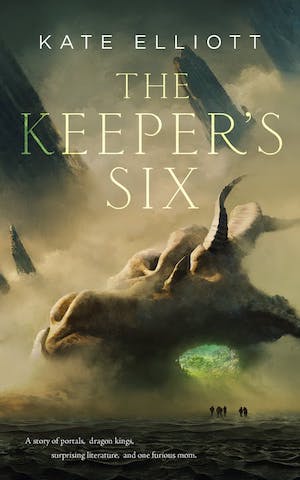

The Keeper’s Six
And overall in Middle-earth, things aren’t great for Men. We’re told the lands are “for the most part savage and desolate” except where anyone who survived the sinking of Beleriand settled.
521 – Birth in Númenor of Silmariën.
Silmariën is the daughter of the fourth king of Númenor, Tar-Elendil (not to be confused with the better-known Elendil the Tall thousands of years later). Up until now, the eldest child of each king has taken the sceptre from his father—the sceptre being the symbol of rulership. But, up until now, the eldest child has always been a boy. So now what? Silmariën is the eldest and she’s a girl. Sadly, Númenórean law at this point hadn’t the good sense to allow for ruling queens. (It will . . . later.) Therefore Silmariën’s little brother, Meneldur, will be given the sceptre and the line of kings will proceed from him, not from her (or the middle child, another daughter).
So why is Silmariën on this timeline? Because her brother’s line will, over the centuries to come, lead Númenor down its ill-fated path. It’s a political divide, and a kind of turning point in history. Now, Silmariën’s own direct descendants will eventually be called the Lords of Andúnië (a port city on the northwestern part of the island, see the map above), and they will become the chief counselors to the ruling monarchs of her brother’s line. More important, it is Silmariën’s descendants who will establish the Faithful, the political faction that tries to remain loyal to the Elves and maintains respect for the Valar when the rest of Númenor goes off the rails. Silmariën is also given the Ring of Barahir and it will be passed down through many generations all the way to Aragorn! One can think of the Lords of Andúnië, Silmariën’s line, as the rulers who ought to have been the kings and queens. Maybe things would have worked out better.
Consider this summation of the family tree of Númenórean royals—where the first king (Elros/Tar-Minyatur) gets things started, where the sceptre gets handed off the firstborn male, and where things end up after the last king seizes the sceptre.
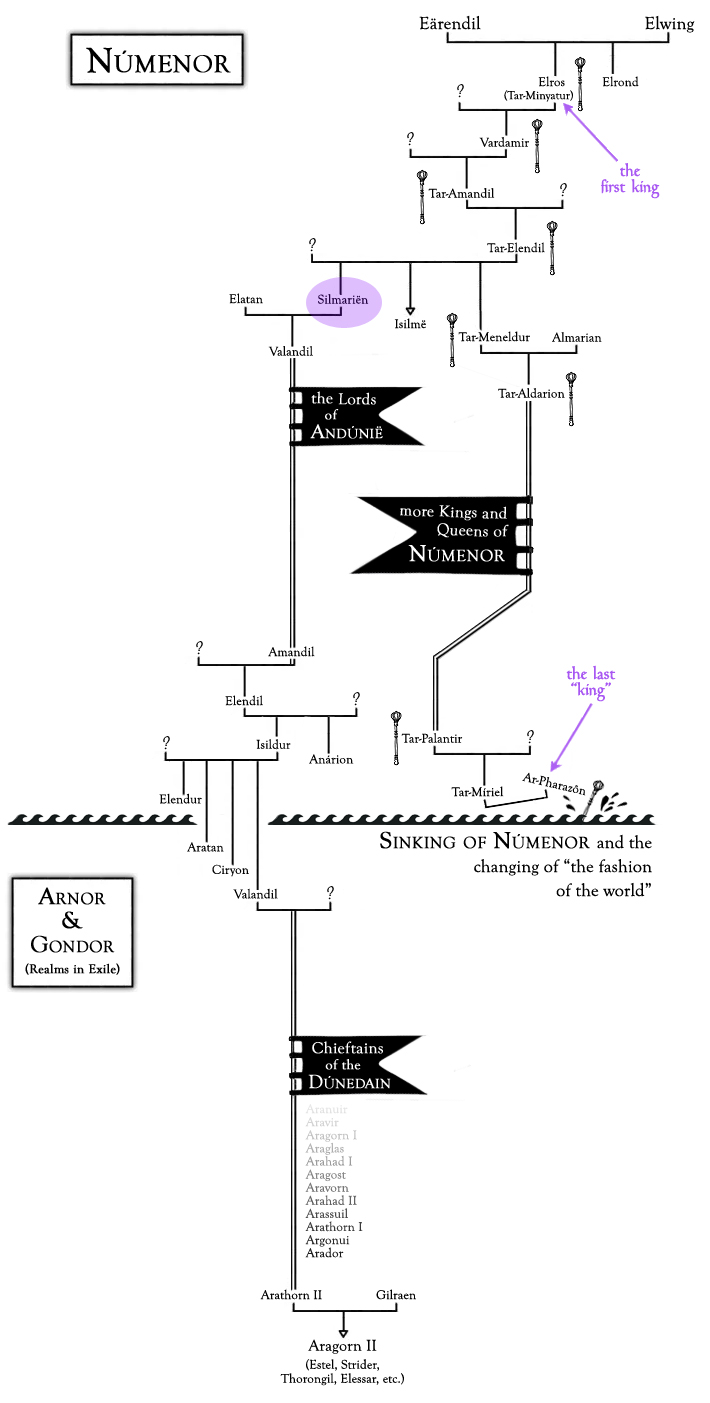
In Unfinished Tales, the story “Aldarion and Erendis: The Mariner’s Wife” gives us a fuller tale about the era of Tar-Meneldur, his son Aldarion, Aldarion’s wife, Erendis, and their daughter, Ancalimë. It paints a good picture of the political climate and the early relations with the elves of Lindon. More about that down below!
600 – The first ships of the Númenóreans appear off the coasts.
So it’s Silmariën and Meneldur’s dad, Tar-Elendil (fourth king), who makes “first contact” with the Men over in Middle-earth since the founding of Númenor five hundred years before. This is now so many normal mortal generations after the Edain had first gone to Númenor—so now, in returning, they’re like myths coming alive to the people of Middle-earth. They are tall Sea-kings who bring gifts and knowledge; they teach them better in the ways of the “sowing of seed and the grinding of grain, in the hewing of wood and shaping of stone.” The Númenóreans lift the spirits of their “lesser” brothers and sisters.
750 – Eregion founded by the Noldor.
Eregion is now a second realm established by the Noldor to be founded since the end of the First Age. This is where Celebrimbor sets up shop with his fellow jewel-smiths in close proximity to Khazad-dûm.
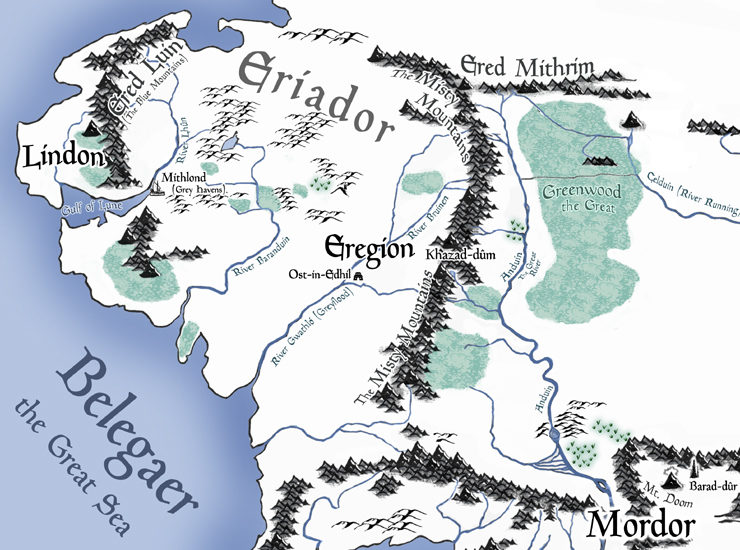
1000 – Sauron, alarmed by the growing power of the Númenóreans, chooses Mordor as a land to make into a stronghold. He begins the building of Barad-dûr.
What Tolkien said. That’s right . . .

But, it’s a secret. Shhhhhh.
1075 – Tar-Ancalimë becomes the first Ruling Queen of Númenor.
A bit of progress . . . but a bit too late. Ancalimë is the first queen, but she’s cold and bitter due to daddy issues (and mommy issues). Appendix A tells us that “it was then made a law of the royal house that the eldest child of the King, whether man or woman, should receive the sceptre.” In Unfinished Tales we learn that this amendment was made “for reasons of private concern, rather than policy” by Ancalimë’s father, Tar-Aldarion. In fact, he did so out of spite toward Ancalimë’s mother. It’s a whole thing. Read “Aldarion and Erendis: The Mariner’s Wife” for the juicy and tragic details! Tolkien was amazing at portraying opposing POVs and convincing you, beat by beat, that the one you’re currently reading in a given moment is the “right” one, only to switch back on you with compelling counterpoint. He’s tricksy.
1200 – Sauron endeavors to seduce the Eldar. Gil-galad refuses to treat with him; but the smiths of Eregion are won over. The Númenóreans begin to make permanent havens.
What the Appendices don’t specify—but The Silmarillion and Unfinished Tales do—is that it’s not like Sauron just went over and tried to con the Elves of Eregion as-is. He does so in the guise of Annatar, a fair and friendly persona that they have no idea is Sauron. But we’re told that Gil-galad and Elrond especially didn’t trust this Annatar fellow, this so-called Lord of Gifts. They wouldn’t give him the time of day, nor entry into their realm of Lindon. Which was fine with Sauron. He really just needed the acquiescence and the skills of Celebrimbor and the Elven-smiths. Galadriel also didn’t trust him, and he was especially careful of her.
1500 – The Elven-smiths instructed by Sauron reach the height of their skill. They begin the forging of the Rings of Power.
Ah, the game is afoot! We’re almost halfway through the Second Age at this point. Pay no attention to the Dark Lord behind the curtain.
1590 – The Three Rings are completed in Eregion.
While Celebrimbor and his fellow jewel-smiths all contribute to the forging of the Rings of Power (under Sauron’s direct tutelage), Celebrimbor himself makes the three elemental-themed rings Vilya, Narya, and Nenya (without Sauron peeking over his shoulder).
And then, ten years later . . .
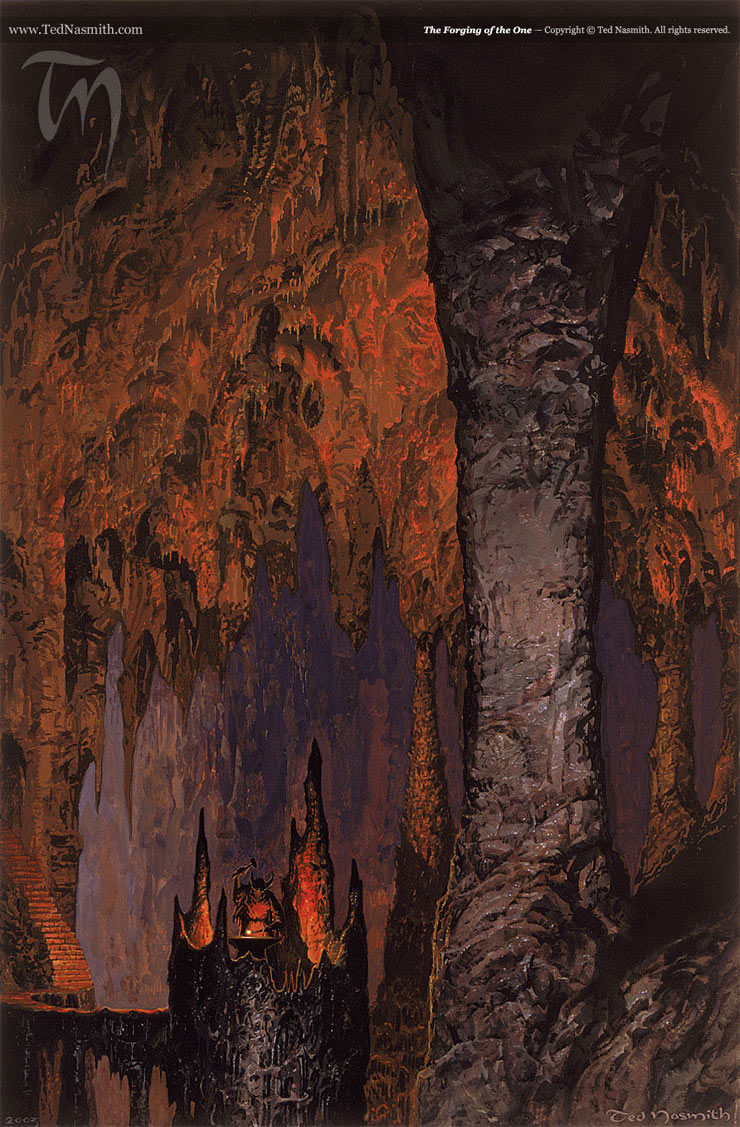
1600 – Sauron forges the One Ring in Orodruin. He completes the fortress of Barad-dûr. Celebrimbor perceives the designs of Sauron.
Oh, the game is on. When Sauron actually completed his Ring, he literally speaks these words in the Black Speech, which Gandalf will one day recite to impress upon the Council of Elrond how dire their situation is:
One Ring to rule them all, One Ring to find them,
One Ring to bring them all and in the darkness bind them.
Notice that it’s not the whole Ring poem we know and love. No talk of Elf-kings and Dwarf-lords. It’s just the two lines of “fiery letters” inscribed on the Ring itself. The rest of that verse “long known in Elven-lore” (according to Gandalf) will be written years later, when the Rings of Power have been repurposed. But right now, the One Ring’s only goal is to enslave the wearers of the sixteen already made. And the Elves of Eregion who actually forged the damned things are late to the Annatar Isn’t To Be Trusted party. Still, in that moment, Sauron’s identity and his role in the scheme is revealed. So the Elves take off their rings. They’re at least not going to make this easy for him.
Sauron is pissed that it doesn’t go off without a hitch. You had one job, One Ring. What part of “rule them all” didn’t you understand?
1693 – War of the Elves and Sauron begins. The Three Rings are hidden.
Ninety three years after the One Ring was forged and Sauron was unmasked, actual war between the Elves and Mordor now begins. What took the war so long, right? In 2021’s The Nature of Middle-earth, we get an explanation for this gap of time. In brief, Sauron wasn’t really prepared for war himself, either (he’d been counting on his ring scheme to do the work for him, and it failed.). Meanwhile Gil-galad and the Elves couldn’t tell how dangerous Sauron’s military force really was, nor did they even know that Mordor was his seat of power.
1695 – Sauron’s forces invade Eriador. Gil-galad sends Elrond to Eregion.
This wording makes it sound like Gil-galad is trying to get rid of Elrond by sending him to the front lines! But really it’s all part of the military movements of the time, most of which are detailed (but also unrefined) in Unfinished Tales in the chapter on Galadriel and Celeborn.
1697 – Eregion laid waste. Death of Celebrimbor. The gates of Moria are shut. Elrond retreats with remnant of the Noldor and founds the refuge of Imladris.
Slow down, professor! We get huge spans of time where it’s unclear anything is happening and them BAM, so much happens at one time. So Celebrimbor and his realm of Eregion are no more! Sauron has gathered up all the Rings of Power the Elven-smiths had made, but despite being tormented Celebrimbor doesn’t give up the location of the Three. So Sauron’s got only sixteen of them. They’ll have to do for now.
Now, the Dwarves don’t shut themselves in Khazad-dûm right away. They actually help out for a while, decent folk that they are, and in Unfinished Tales we even get a few brief mentions of their direct participation in this war. At one point they save Elrond’s butt by attacking Mordor’s forces “in the rear”! But in retaliation Sauron goes after them, so at last they head into their mountains and slam the door. The Dwarves are out of the game. They’ve done enough for those troublemaking Elves, haven’t they? Meanwhile, Elrond takes the remains of the Noldorin Elves, goes north, and establishes Rivendell.
1699 – Sauron overruns Eriador.
Looks like it’s game over, man. Sauron’s forces have either slain or driven the Elves away. But . . .
1700 – Tar-Minastir sends a great navy from Númenor to Lindon. Sauron is defeated.
The Númenóreans have been ignoring their alleged Elven friends for centuries (basically, since Ancalimë was queen) because they’ve become rather self-absorbed. But Tar-Minastir, the eleventh king of Númenor, makes up for that by sending some help against Sauron! And it makes all the difference.
1701 – Sauron is driven out of Eriador. The Westlands have peace for a long while.
The good news is, things calm down in Eriador for a while. The bad news is, Númenor now has Sauron’s full attention (but they don’t know it yet).
1800 – From about this time onward the Númenóreans begin to establish dominions on the coasts. Sauron extends his power eastwards. The shadow falls on Númenor.
This is a nice way of saying that Númenóreans now go from saviors to conquerors, from helpers to subjugators. Thus “the shadow” of evil falls on them. They’re becoming imperialists. While most still live on the island itself, plenty now live on the coasts of Middle-earth. They start demanding tribute from the “lesser” men who live here. It’s not a good look.
Now we’re going to jump ahead some two-hundred fifty years.
2251 – Death of Tar-Atanamir. Tar-Ancalimon takes the sceptre. Rebellion and division of the Númenóreans begins. About this time the Nazgûl or Ringwraiths, slaves of the Nine Rings, first appear.
Tar-Atanamir was a real piece of work. He was the thirteenth king of Númenor, but the first one who actually refused to give up the sceptre to his heir at the rightful time, so he clings to his rulership even as he becomes “witless” and infirm. His son has to pry it from his cold dead hands, not the sign of good health in the royal psyche. Númenóreans, especially the royals, are already long-lived compared to “lesser” Men, but it’s not enough for them. They’ve been fretting about their own mortality for centuries. Now they’re becoming obsessed with it.
Meanwhile, Sauron has not been idle. His Rings of Power scheme didn’t work on the Elves, so he’s enacted a plan B, which is to redistribute the sixteen Rings of Power he recovered. Seven end up with seven Dwarf lords, but the domination effect doesn’t quite take. Stubborn Dwarves! Sauron doesn’t get control of them just like that. But the remaining nine rings? He’s now used them to ensnare nine kings of Men, and that at least paid off. Enter the Ringwraiths, three of whom were Númenóreans obsessing over mortality. Do these new rings give them extra life? Nope, but it stretches it out terribly.
2280 – Umbar is made into a great fortress of Númenor.
South of where Gondor will one day be settled, Umbar is a coastal city from which the Númenóreans have become like Conquistadors. Umbar will one day be where the worst of the surviving Númenóreans will operate, the ones called Black Númenóreans. This is where the Haradrim (under Sauron’s sway) and the Corsairs will one day set sail in the War of the Ring.
2350 – Pelargir is built. It becomes the chief haven of the Faithful Númenóreans.
The Faithful are the Númenóreans still trying to walk the straight and narrow path of loyalty to the Elves and the Valar who first blessed them. They’re led by the Lords of Andúnië, the descendants of Silmariën. Remember her?
Umbar and Pelargir are the two main harbors on Middle-earth’s coast from which the survivors will rally when things go really pear-shaped for Númenor.
2899 – Ar-Adûnakhôr takes the sceptre.
Ar-Adûnakhôr is the twentieth king of Númenor. Note that we’ve gone from the Tar- prefix (Quenya for “high” or “noble) to the Ar- prefix (Adûnaic for the same). This is another cultural shift, and a pushing out of all things Elvish and Valarian. In fact, three kings later, all the Elven tongues will be forbidden. Then it’s truly all Adûnaic (the Mannish language) all the time! #NúmenorFirst
3175 – Repentance of Tar-Palantir. Civil war in Númenor.
After a string of crappy asshole kings who’ve lost sight of history and what Númenor used to be, we get Tar-Palantir. He’s actually a good king, and he tries his best to roll things back, to “repent” of his predecessors. But his younger brother takes after their father and becomes the leader of the King’s Party (as opposed to the Faithful). This political schism becomes a kind of cold civil war.
3255– Ar-Pharazôn the Golden seizes the sceptre.
Pharazôn is Tar-Palantir’s own nephew, but by means not quite fleshed out by Tolkien, he seizes the sceptre of rulership by forcibly marrying his uncle’s daughter and heir, Míriel. She should have been Queen Tar-Míriel. But Pharazôn is a usurper, and it seems the people, most likely under his political sway, simply allowed this act to stand. It bodes poorly for all! He’s one of the leaders of the King’s Men, a faction dead-set against Elves, against the authority of the Valar, and against anything standing in the way of Númenor becoming a global immortal superpower.
Here’s a graphic summary of the timeline up to this point that I worked up for the The Silmarillion Primer.

3261 – Ar-Pharazôn sets sail and lands at Umbar.
Ar-Pharazôn is a king of action. He goes to Middle-earth himself, while king, to direct his imperial forces.
3262 – Sauron is taken as prisoner to Númenor.
Such a tantalizing short entry. Sauron has seen the writing on the wall, and knows that Númenor can’t be defeated by military force, not even with the might of Mordor and the One Ring on his finger. But it can be undermined and rotted out from the inside, can’t it? They’re still just mortal men, ain’t they? Númenor has already got the shadow of evil upon it (a legacy of Morgoth, his old boss!). So Sauron goes forth, as himself with no alias, and surrenders to Ar-Pharazôn. They sail with him as a captive back to their island.
3262–3310 Sauron seduces the King and corrupts the Númenóreans.
Yadda yadda yadda, the long run of poor decisions made by the Númenóreans for the last millennium and a half has led to . . . this final lap of even worse decisions. Even as a captive, Sauron with his lying silver tongue has wormed his way into the king’s close counsel. Like an evil bellows, he fans the flames of Ar-Pharazôn’s pride and fosters the fear of death (which, he insists, the Valar have foisted upon Men). The king becomes the worst of tyrants; the Faithful are persecuted, and Sauron even introduces the worship of Melkor (aka Morgoth) among them. Ar-Pharazôn begins to venerate “the Dark.” Yikes. Eventually, blood sacrifices are made in a temple. It’s bad. Like bad-bad.
3310 – Ar-Pharazôn begins the building of the Great Armament.
Númenor already represents the pinnacle of human technology and skill. Now Ar-Pharazôn turns the dial up to 11, heavy with intent. This intense military buildup is “the greatest that the world has seen.” Ruh-roh. Sauron has wound up these immortality-seeking Númenóreans and is now pointing them at the Lords of the West. At Valinor itself. Does he think the Númenóreans could actually take down the Valar in the Undying Lands? He’s got to know that’s unlikely, but reckons they can do some real damage (if so, that’s a win for him). Either way, Sauron’s goal isn’t to eliminate the West so much as it is to eliminate the greatest threat to his domination of Middle-earth: Númenor itself.
Remember the white tree? Somewhere during this period Sauron tries to convince Ar-Pharazôn to cut it down; it’s a symbolic link to the Elves and the Valar, and he wants it gone. But before the king caves in, a young man named Isildur, grandson of the king’s advisor and part of Silmariën’s bloodline (remember her?), sneaks into the court where the white tree Nimloth was placed. He cuts a fruit from the tree and barely escapes with his life. Thus the next sapling has a chance to survive these dark days!
3319 – Ar-Pharazôn assails Valinor. Downfall of Númenor. Elendil and his sons escape.
It doesn’t get more succinct than that. Sauron’s plan finally works. A massive armada sails out of Númenor and lands on the shores of Aman, the Undying Lands, intending to pick a fight if necessary. Intending to, I guess, wrest the power of immortality out of the Valar? Now, for their part, the Valar aren’t quite sure what to do about this situation; they’ve been very hands-off when it came to the doings of Men. So instead of squashing them, Manwë, the King of the Valar, appeals to Eru Ilúvatar himself.
Eru, the One, simply removes Númenor—along with any temptation Men may have of accessing the Undying Lands ever again—from the equation. He does this by changing the shape of the world itself and sinking the entire island kingdom. The seas “bend,” everything gets a bit more round and less flat-Earth-like, and down Númenor goes into the devouring waves, taking almost everyone down with it. Even Sauron, which wasn’t quite how he was expecting this to go.
Now, there are survivors, but not many. We have Elendil, descendant of Silmariën and the Lords of Andúnië. We have his sons Anárion and Isildur (the aforementioned saver of fruit), who escape with an unknown number of their families and friends, others of the Faithful. They make it to their havens in Middle-earth.
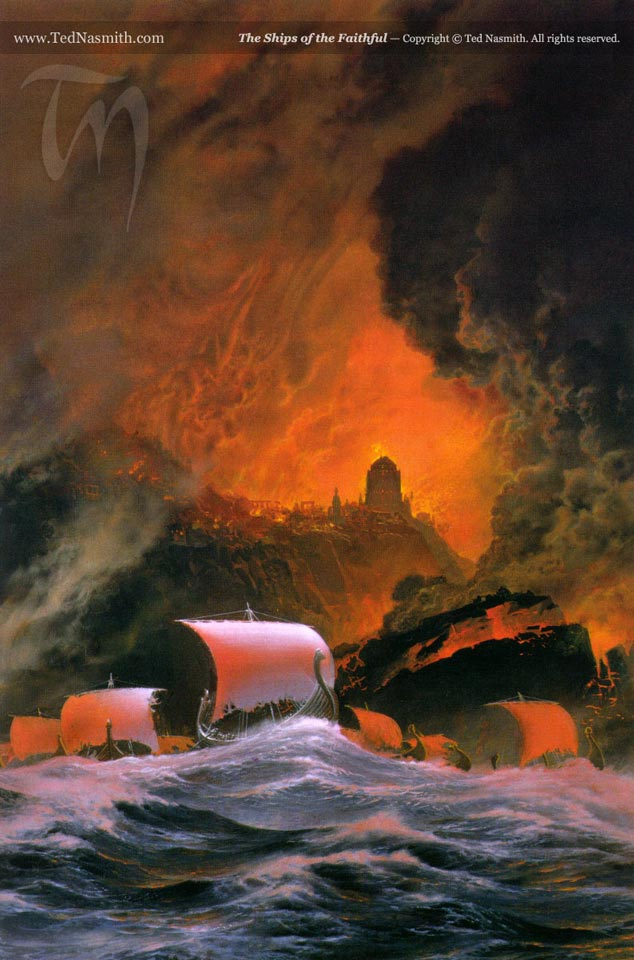
3320 – Foundations of the Realms in Exile: Arnor and Gondor. The Stones are divided. Sauron returns to Mordor.
Elendil and his boys waste no time getting the two kingdoms underway. They’re setting up shop all over the map, even right up against Mordor! They managed to save seven of the Seeing-stones, the palantíri, from the wreck of Númenor, and now the stones are spread out across the Realms in Exile for practical use. In the newly minted southern kingdom of Gondor, which both Isildur and Anárion govern together, four of the palantíri are placed: at Minas Anor, Minas Ithil, Osgiliath, and Orthanc. In the northern kingdom of Arnor, where their dad, Elendil, becomes king, three are placed: at Annúminas, Amon Sûl, and the Tower Hills near the Grey Havens.
Meanwhile, Sauron, reforming as “an image of malice and hatred” after having gotten sucked down into the abyss with Númenor, goes back to Mordor. He’s not at all pleased that Middle-earth isn’t ripe for an easy takeover.
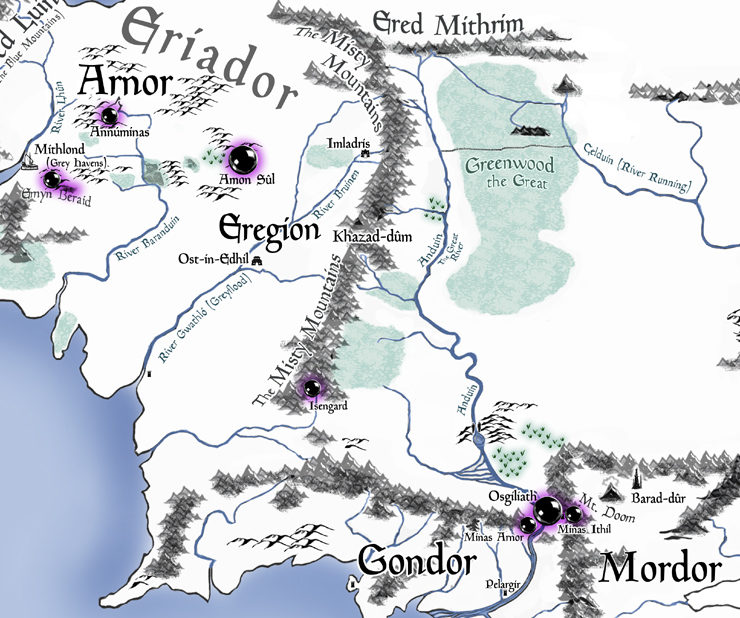
3429 – Sauron attacks Gondor, takes Minas Ithil and burns the White Tree. Isildur escapes down Anduin and goes to Elendil in the North. Anárion defends Minas Anor and Osgiliath.
Gondor and Arnor are now over a hundred years old and Sauron’s had it with these despicable Faithful. He finally goes on the offensive when he’s strong enough. He captures Minas Ithil, the Tower of the Moon, but, ehh, Gondor will get it back again.
3430 – The Last Alliance of Elves and Men is formed.
The final team-up has begun. Sauron’s days are numbered, but victory by sheer military force will be hard won.
3431 – Gil-galad and Elendil march east to Imladris.
Gil-galad, the last High King of the Noldor, and his mortal friend Elendil soon meet up at Rivendell. And Elrond joins the band (as Gil-galad’s herald)! But note that it does take a few years for them to muster the force to march out again.
3434 – The host of the Alliance crosses the Misty Mountains. Battle of Dagorlad and defeat of Sauron. Siege of Barad-dûr begins.
The final showdown begins. It’s long and grueling. The Last Alliance is there within the bounds of Mordor, battling for years. It’s mostly Elves and Men vs. Orcs and other Men, but there are Dwarves who’ve marched out of Khazad-dûm to help out the good guys, too. It’s a massive war.
3440 – Anárion slain.
Isildur’s kid brother and co-king of Gondor, now dead, six years into the fight.
3441 – Sauron overthrown by Elendil and Gil-galad, who perish. Isildur takes the One Ring. Sauron passes away and the Ringwraiths go into the shadows. The Second Age ends.
Gil-galad and Elendil have their legendary battle with the Dark Lord, laying down their lives in the process, but also laying low Sauron himself. His physical form is beaten in this total boss-fight. Isildur then takes the broken sword Narsil and uses it to cut the One Ring from Sauron’s hand. He sees it as compensation for the loss of his brother and father. Bad move, of course. He does this despite Elrond and Círdan’s urging him to throw the Ring into the fires of Mount Doom. Isildur says thanks but no thanks, which basically assures that Sauron will be back for the sequel.
But in Isildur’s defense, that’s not obvious. Yes, Elrond and Círdan are both wise and their counsel to toss the Ring is the right call no matter what; it was made by Sauron, which means “the Abhorred,” and who had been known among the Sindarin Elves as Gorthaur the Cruel. He was a masterful crafter; anything he makes with his own hands is going to be bad news for anyone. Like, if the survivors of the Last Alliance found some macaroni art in the dungeons of Barad-dûr that Sauron had made in his spare time, it would be evil macaroni art and they would be well-advised to either leave it alone or destroy it.
Anyway, my point is, at this point in history, Sauron seems to be donezo. Defeated. Dead, even. He has ceased to be. He is an ex-Dark Lord. And this apparent demise marks the end of an era. Everyone tossed in their Second Age calendars.
And there we have it: the Second Age in a big, bloody, ring-filled nutshell. The Second Age is basically a 3.4-millennium period where Sauron starts off quiet, attempts to trick the Elves into slavery, tries to kill them when that doesn’t work, and though he does manage to wreck a lot of their lands, he’s driven back by the upstart Elf-friends (the Númenóreans), so he changes gears and spends all his efforts on undermining their empire from the inside, only to overreach a bit when their island sinks and the world changes, but, upon returning to Middle-earth, he finds that the Elves and their mortal allies are still in his way, and though he arms up again, this time they beat him up soundly.
Here is another timeline graphic I made back in February when all we had to go on were those Rings of Power character posters and I started to muse on what Tolkien wrote vs. what the showrunners might be doing. Notice the span of time. Notice that when Ar-Pharazôn comes onto the scene, the Rings of Power are old news, Celebrimbor already dust. And Sauron has his Ruling Ring during the whole Númenórean debacle.

For all that Tolkien wrote, there is plenty that he didn’t. It’s known that in The Rings of Power show we’ll be meeting a young woman named Eärien, who is presented as Isildur’s sister. Tolkien didn’t say Isildur had a sister, but he didn’t say he didn’t. Who’s to say? There are lots of women who must have existed but who are not named. Where is Isildur’s mom? Elendil’s wife. We’ve got nothing, not even a name. Obviously, she existed, too. It was much later in Tolkien’s life, as accounted for in the latter volumes of the History of Middle-earth books, that he started to go back and retcon more female characters (Galadriel included). Suddenly some of the wives and sisters who must have been there all along begin to appear. Maybe they’d have factored more into the stories, had Tolkien more years in him.
Where To Actually Read about the Second Age
Okay, no more of my paraphrasing. What did Tolkien actually write about the Second Age?
As an introduction to Númenor, you can always just read the first section from Appendix A of The Lord of the Rings, I. The Númenórean Kings. It’s a bit on the dry side, relatively speaking, but it gives the high-level overview and then a big list of monarchs, then goes into the legacy of Númenor, which are the Realms in Exile (Arnor and Gondor) and eventually presents the tale of Aragorn and Arwen. All fantastic information.
If you want to know the “full” tale of Númenor, the best place to go is The Silmarillion itself. The second to last part of the book is called The Akallabêth and it’s the primary narrative of the fabled Men of Westernesse, beginning to end. I walked through the basics in these two installments from my Silmarillion Primer:
But there are even more details to be found in 1980’s Unfinished Tales of Númenor and Middle-earth. Read the Second Age chapters in Part Two:
- I. A Description of the Island of Númenor – Mostly just a geographical report of the island itself, its resources, and a hint of the culture and seamanship of its people.
- II. Aldarion and Erendis: The Mariner’s Wife – An actual in-depth story, this one, telling the tale of the sea-loving sixth king (Tar-Aldarion), how he took over from his star-loving and wiser father (Tar-Meneldur), and how his on-again-off-again romance and marriage to Erendis led to him changing the laws so that daughters could inherit the sceptre. It’s a melancholic tale with a chilly ending; in some ways, it’s a good and sadly realistic foil to the better known Aragorn/Arwen and Beren/Lúthien stories. It also features the moment when the king receives a letter from Gil-galad, in which the Elf-king first voices his concern about “a new shadow” stirring that he deems to be “a servant of Morgoth.”
- III. The Line of Elros: Kings of Númenor – A literal list of the kings and queens of Númenor, but it’s not a dry read. Each ruler is given at least a short paragraph (some quite a bit more) describing how they differed from those before and after.
The twelfth volume of The History of Middle-earth series, The Peoples of Middle-earth, includes the very unfinished “Tal-Elmar,” which is a strange disjointed little story that doesn’t neatly tie into other writings, but it gives us some idea how the Númenóreans might have been seen by some of the “lesser” men on Middle-earth during their years of imperialism. It’s unclear what year this takes place, but one of the main characters says that the “High Men of the Sea” are to be feared, “For Death they worship and slay men cruelly in honour of the Dark.” Yikes. That sure sounds like the days of Ar-Pharazôn, doesn’t it? In the same book, the section “Of Dwarves and Men” provides a bit more about the role of Dwarves, in alliance with Men, during the Second Age (amidst more general Dwarven lore).
Now, The Nature of Middle-earth, which was published in 2021, gave us a whole bunch more about Númenor and its culture. Do yourself a favor and read Chapter XIII of Part Three, “Of the Land and Beasts of Númenor.” Foxes, squirrels, sheep, horses, birds, fish, narwhales, dolphins . . . and bears. Oh my, but there sure are bears on Númenor. And not idle bears, at that.
But now to the matter of the Rings of Power as Tolkien devised it.
If you want to know the “full” account of Sauron’s ring-based pyramid scheme, you’ll find only tantalizing brief summaries in the Appendices of The Lord of the Rings and then a richer account in “Of the Rings of Power and the Third Age,” the final part of The Silmarillion. To me, the key difference between the two is that in LotR we’re not told that those first sixteen Rings of Power made by the Elven-smiths of Eregion weren’t intended to go to Dwarves and Men at all. Remember, the full Ring poem isn’t written upon the One Ring; that was devised at some point after the “Dwarf-lords in their halls of stone” and the “Mortal Men doomed to die” were roped in. It’s a bit misleading. In any case, I also walked through this in two installments in the Primer:
- Twenty Rings, Seven Stones, and Middle-earth’s New Dark Lord
- The Misappropriation of the Rings (and the Third Age)
Going back to Unfinished Tales, there’s a lot more detail in the final chapter of Part Two:
- IV. The History of Galadriel and Celeborn – This is a fun but tangly mess that sounds like it’s going to give you the before-she-was-famous scoop on Galadriel, only to give you several contradicting versions of her biography. Peppered in are all kinds of gratifying details about the war between the Elves and Sauron after the Rings of Power were made. Plus there’s a bit more about Celebrimbor and his gruesome fate. Poor chap. This is also the place to read about a more active, fiery Galadriel, especially in her youth. She is described as “a match for both the loremasters and the athletes of the Eldar” in their earlier days.
Lastly, and this is a bit of a deviation, there are some abandoned stories (a Tolkien trend) found in the third and ninth volumes of The History of Middle-earth series. This isn’t so much a deeper dive on the subject of Númenor as it is just a dive into a different but certainly adjacent pool. In The Lost Road and Other Writings (volume 5) you will find the genesis of Númenor, for it was Tolkien’s 1930s reimagining of Atlantis as a writing experiment he shared with his friend C.S. Lewis. The agreement: Lewis would write a space-travel story (what ended up becoming his Space Trilogy) and Tolkien would write a time-travel story (wherein Atlantis-but-really-it’s-Númenor was born). In Sauron Defeated (volume 9) we find the even more complex The Notion Club Papers, wherein Tolkien revisits his time-travel story and tries again to develop his Númenórean ideas and tie them into the modern-day real world. To continue with the diving metaphor, this is like if you jump into the deep end of the pool only to discover a hatch to a second, even-deeper pool beneath it. Is it good stuff? Yup, but it’s still kind of a doozy, and probably not the best place to start if you just want to know more about the Second Age in Middle-earth.
A lot of the above will be compiled in an upcoming release, The Fall of Númenor, edited by the meritorious Brian Sibley. I don’t think there will be anything truly new in that book, but having most Second Age lore in one place will be great for fans.
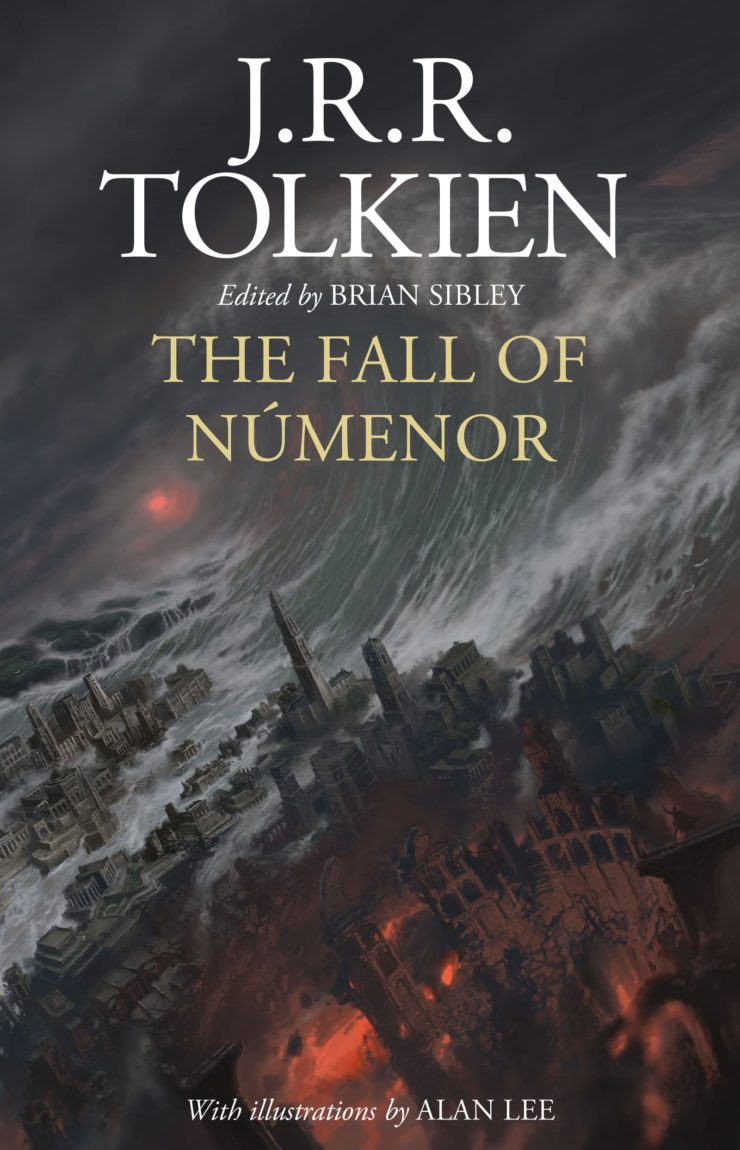
Jeff LaSala—aside from feeling that people don’t talk about Silmariën enough—is responsible for The Silmarillion Primer, the Deep Delvings series, and a few other assorted articles on this site. Tolkien nerdom aside, Jeff wrote a Scribe Award–nominated D&D novel, produced some cyberpunk stories, and works in production for Macmillan and the Tor Publishing Group. He is sometimes on Twitter.










